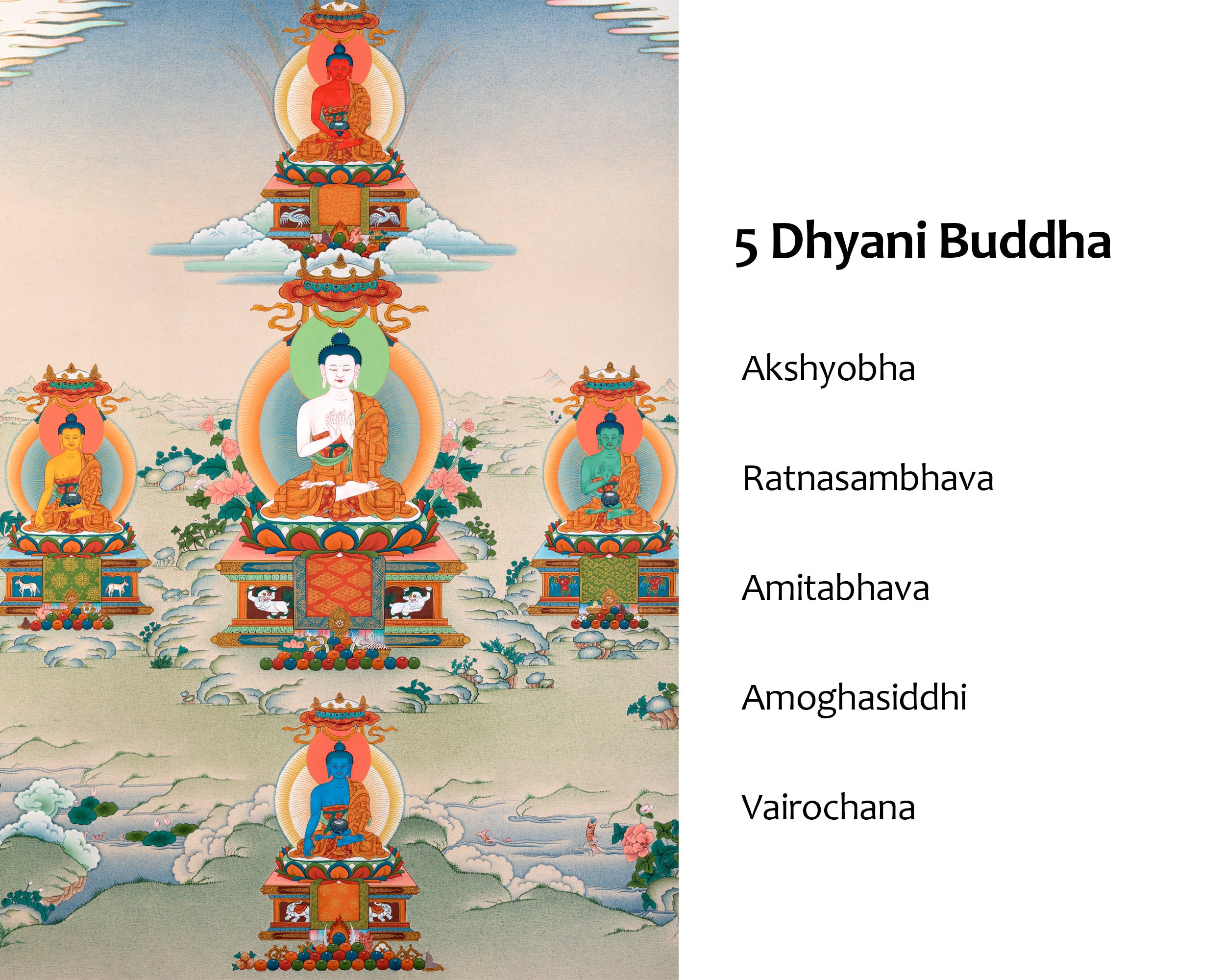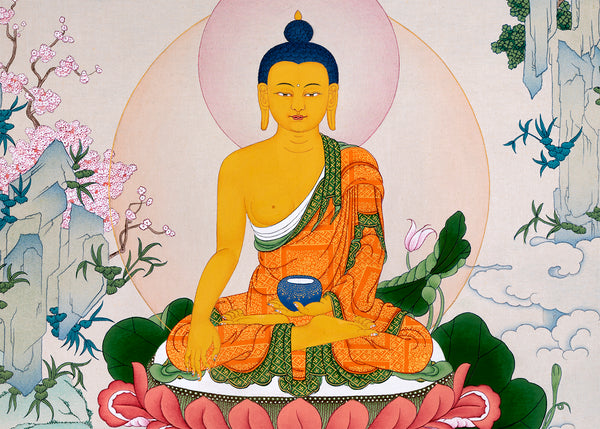The Five Dhyani Buddhas: Vairochana, Amitabha, Akshobhya, Ratnasambhava, Amoghasiddhi
Enlightenment is beyond conceptual understanding and can only be realized experimentally. Every Buddhist movement through the ages had advanced literary, symbolic, visual, and performative expressions of the enlightened state.
The Five Dhyani Buddhas, a fivefold mandala is a paradigm for Tantric symbology.
The ultimate and transcendent state of Buddhahood, (dharmakaya), is inconceivable to those who have not experienced enlightenment. Thus, Buddhas emanate an array of physical forms, both corporeal and subtly visionary. He leads others to the same realization. The bliss-body (sambhogakaya) is a way of depicting the essence of Buddhahood in art form.
In Tantric Buddhism, one of the primary formulations of the sambhogakaya is the five Jina Buddhas. Together, they offer a reference to the qualities, the totality of enlightenment. There are fivefold sets of paintings or sculptures devoted to the Jinas. As well as the representations of their mandala and their appearance are found in artistic representation. The concept of the five Jinas is fundamental to Tantric Buddhism. They are inherent in virtually every Tantric work of art, whether or not they are present in figural form. Their imagery is used to symbolize attainment at many levels.
For instance, the Jina Buddhas appear in the crowns of many deities. They represent an expression of past attainment or as a promise of future attainment.
The five Jinas are envisioned in the fivefold mandala array. One in the center and the other four inhabit quadrants in the cardinal directions. Each of the five presides over a Buddha "family," or kula. This may further be articulated into additional figures that appear in and embody the sector of the mandala.
Each Jina has a female counterpart, known as a Buddha-prajna, or Jina-prajna. They represent the feminine aspect of enlightenment, wisdom(prajna). The female in union the male expresses the nondual realization of enlightenment. This symbolism is always implied in Tantric Buddhism whether the male and female are both presents in a given visualization.
As bliss-body Buddha forms, the Jina Buddhas are envisioned as regal figures residing in paradisal realms of splendor. They are richly robed, crowned, and ornamented. Their adornments have symbolic significance, expressing their spiritual status as sambhogakaya Buddhas. Specifically, their iconography displays the thirteen ornaments of the sambhogakaya:
Five silk items:
1) Ribbons (ties on the crown)
2) Upper garment (rarely depicted)
3) A silk scarf (billowing behind him)
4) A sash at the waist (hidden)
5) Lower garment (dhoti)
Eight Jeweled Ornaments:
6) Crown
7) Right and left earrings (count as one)
8) Gorget
9) Two armlets (count as one)
10) Long and short necklaces (count as one)
11) Two bracelets (count as one)
12) Finger rings (count as one)
13) Two anklets (count as one)
Other "understood" elements:
The gold Bindu of yogic attainment emerging from the top of the head
1. Mount Meru topknot (meru jata) hair arrangement
2. Crown of the five Buddhas, symbolizing enlightenment
3. Lotus seat of transcendence
4. Moon or sun disk (on a lotus) of perfect wisdom
5. Existence only in the heart-mind of the practitioner
Each Jina Buddha represents one of the five transcendental insights. It comprises the fully enlightened mind. Each transcendental insight is an antidote to one of the five mental poisons. These egoistic mind-states are toxically painful and inherently destructive. Visualization of the Jinas transforms these negative mind states into their positive counterparts. It then transmutes the poisons of the unenlightened state into enlightenment.
The mandala of the Five Jina Buddhas begins with Akshobhya. The "Unshakable One," presides over the eastern sector. And is shown at the bottom in the thangka. He is blue in color and performs the earth-touching gesture (Bhumisparsha mudra). Shakyamuni Buddha displayed this gesture when he gained victory over Mara (Maravijaya) and overcame all egoic forces.
As the first step in the east of Mandala, this gesture represents the plateau of attainment and stability. It denotes the steadfastness of Akshobhya.
The transcendental insight represented by him is mirrorlike wisdom (Adarsh jnana). This reflects the world as it is, without egotistic distortion. It is the antidote to the poison of anger, or hatred, a major cause and result of egotistic bias and prejudice. He presides over the Vajra family. The emblem is vajra and the symbolic animal is the elephant.
The second step in a clockwise movement around the mandala is the southern portion. It appears on the left of the thangka painting. Here is the residence of Ratnasambhava, "Jewel-Born." He is yellow in color. He performs the gift-bestowing gesture (Varada mudra) with his right hand. His transcendental insight is the equality of all things (Samata jnana). It is the antidote to pride. It is the realization that all beings are equally deserving of abundance and well-being.
Those with the realization of this equality want to give generously to all beings. From material prosperity to the ultimate gift of Dharma. Ratnasambhava presides over the Jewel family. The emblem is the wish-fulfilling gem and the symbolic animal is horse.
The western sector of the mandala is the abode of Amitabha. His name means "Boundless Amitabha". He is red in color and displays the gesture of deep meditation (dhyana mudra).
His transcendental insight is discriminating wisdom (Pratheeksha jnana). It is the antidote to selfishness, lust, and greed. These poisonous manifestations of desire, driven by ego, are based on illusions regarding the true sources of satisfaction and entail blindness to the needs of others. Discriminating wisdom, born of meditative awareness reveals the ultimate source of happiness. Amitabha presides over the Lotus family. He emblematized the pure lotus blossom and the animal emblem is the peacock.
The northern sector of the mandala, pictured on the right of the thangka, is the abode of Amoghasiddhi.
His name means "Unfailing Success," or "Unlimited Accomplishment." This Jina Buddha is green and his right hand is in the fear-not gesture (Abhaya Mudra). The transcendental insight associated with Amoghasiddhi is that of perfected action (kriyanushthana jnana). It is the antidote to envy and jealousy, and accomplishment. Freed from this self-centered concern, it is possible to engage fearlessly in liberative activities.
He presides over the Karma (Action) family. Emblematized by the double-vajra (Viswa vajra), Garuda, the mythical bird is the animal emblem of Amoghasiddhi.
Vairochana, "Intensely Luminescent One," resides in the center. He is white, pure consciousness. He performs the gesture of turning the wheel of Dharma (dharmachakra mudra). His's status represents the source of all illumination. This is the ultimate emanator of all Dharma teachings in Akanishta Paradise. His transcendental insight is a full understanding of truth and reality (dharmadhatu jnana). It is the final antidote to delusion, ignorance, unknowing. It is omniscience, complete awakening, and the ultimate goal of all Buddhism.
Thus, Vairochana presides over the Buddha or Tathagata family. His emblem is the Dharma wheel and the symbolic animal is the lion.
The fivefold Buddha mandala is a template for many mandalas. This remains a pervasive motif and unifying principle of Tantric Buddhist art.



2 comments
Selin
Thank you so much for these valuable teachings.
mireya
¡¡¡maravilloso!!!. gracias